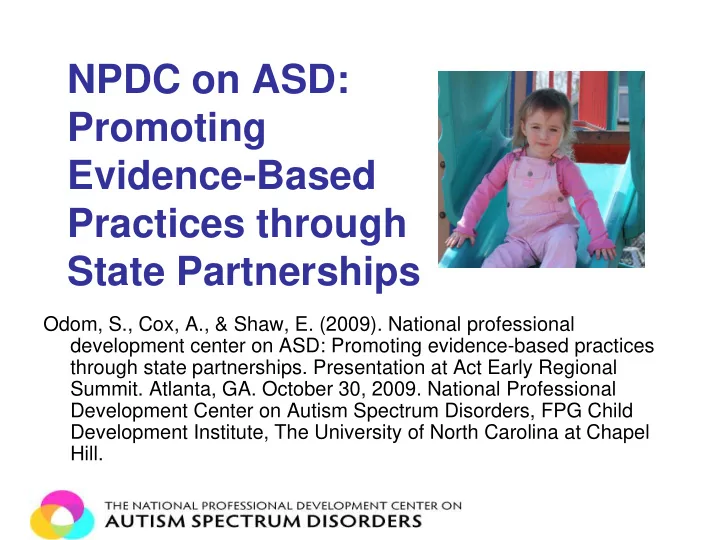

NPDC on ASD: Promoting Evidence-Based Practices through State Partnerships Odom, S., Cox, A., & Shaw, E. (2009). National professional development center on ASD: Promoting evidence-based practices through state partnerships. Presentation at Act Early Regional Summit. Atlanta, GA. October 30, 2009. National Professional Development Center on Autism Spectrum Disorders, FPG Child Development Institute, The University of North Carolina at Chapel Hill.
National Professional Development Center on Autism Spectrum Disorders A multi-university center to promote use of evidence- based practice for children and adolescents with autism spectrum disorders FGP Child Development Institute, University of North Carolina at Chapel Hill; M.I.N.D. Institute, University of California at Davis Medical Center; Waisman Center, University of Wisconsin at Madison
Goals of the National Center • Promote development, learning, and achievement of children with ASD and support families through use of evidence-based practices • Increase state capacity to implement evidence- based practices • Increase the number of highly qualified personnel serving children with ASD
What do we do?
Bridge the Gap Replicable practices in the classroom Research- based practices
Four Areas of our Work Professional Development Technical Evaluation Assistance Content Development
Content Development • Identify/define criteria for evidence • Identify evidence-based practices • Develop online introductory course on ASD • Develop briefs/modules on evidence-based practices • Develop content of summer institute
Professional Development • Offer online foundational course • Conduct intensive 5-day training institute • Use briefs/modules on evidence- based practices for training • Provide training/coaching on implementation of evidence-based practices • Offer modules and briefs online through OCALI and on NPDC website
Technical Assistance • Complete state strategic plan • Develop model sites • Monitor onsite training/coaching/mentoring • Facilitate cross-state/site communication
Evaluation • Content • Professional development • Technical assistance • Outcomes Child – Goal Attainment Scaling Family – Family Program Questionnaire Practitioner - EBP Inventory Program - APERS
Program Quality Indicators and Evidence Based Practices
Program Quality Indicators and Evidence-Based Practice (EBP) Program Quality • Contextual features of the program that represents best practices • Program quality as the house in which practices are employed
Program Quality Indicators and Evidence-Based Practice (EBP) EBP • Evidence-based practices as specific tools for specific skills • EBP as the furniture or appliances designed for specific functions
Autism Program Environment Rating Scale • Designed to assess quality indicators of programs for children and youth with ASD • Purposes of the APERS Program evaluation Consultation Self-evaluation Professional development
Autism Program Environment Rating Scale
Evidence-Based Practices (EBPs)
What are EBPs? Focused interventions that: • Produce specific behavioral/developmental outcomes for a child • Have been demonstrated as effective in applied research literature • Can be successfully implemented in educational settings (Odom, Boyd, Hall, & Hume, 2009)
NPDC Criteria To be considered an evidence-based practice: • Two randomized or quasi-experimental design studies, • Five single subject design studies by three different authors, OR • A combination of evidence such a one group and three single-subject studies
Collaboration with OCALI and Partners for Module Development http://www.autisminternetmodules.org/
How do we use EBP? With With practitioners students &TA providers • Achieving IEP goals • Providing training/fidelity • Developing skills • Providing technical assistance/coaching • Monitoring progress • Monitoring progress • Measuring outcomes
Evidence-Based Practices: Birth - Two • Little literature to document efficacy of focused intervention with age group; emerging science. • Some defensible practices for early intervention: Parent-implemented interventions Naturalistic interventions employed in the home Current work on joint attention & prelinguistic communication Discrete trial training for older 2 year olds
Early Identification and Intervention Long Term Goal #1 : Identification of specific EBP will lead to better identification of and intervention with very young children with ASD. Long Term Goal #2 : An emphasis on early identification and intervention during each state’s strategic planning process will enable states to better address the needs of the 0-3 population.
Partnership With States
State Involvement MN WI MI IN CA VA KY NM TX Cohort 1 Cohort 2 Cohort 3
Would you Like to Become a State Partner? Access state application forms and instructions at center website www.fpg.unc.edu/~autismpdc
Recommend
More recommend